Begonia Ferox, a captivating species among begonias, is known for its unique appearance and fascinating characteristics. This delightful plant belongs to the Begoniaceae family, and it’s native to the rainforests of Brazil. If you’re wondering what sets the Begonia Ferox apart, let’s delve into its distinguishing features:
Key Features of Begonia Ferox:
- Leaves: One of the standout features of Begonia Ferox is its striking, asymmetrical leaves. They are textured with tiny, hair-like structures that give them a rough appearance, almost resembling the scales of a reptile.
- Size: These begonias typically grow to a manageable size of about 12 to 18 inches, making them suitable for both indoor and outdoor settings.
- Blooms: While the foliage is the primary attraction, Begonia Ferox does produce small, inconspicuous white or pale pink blooms. However, it’s the leaves that steal the spotlight.
- Toxicity: Like many begonias, Begonia Ferox is toxic to pets, so ensure it’s kept out of their reach.
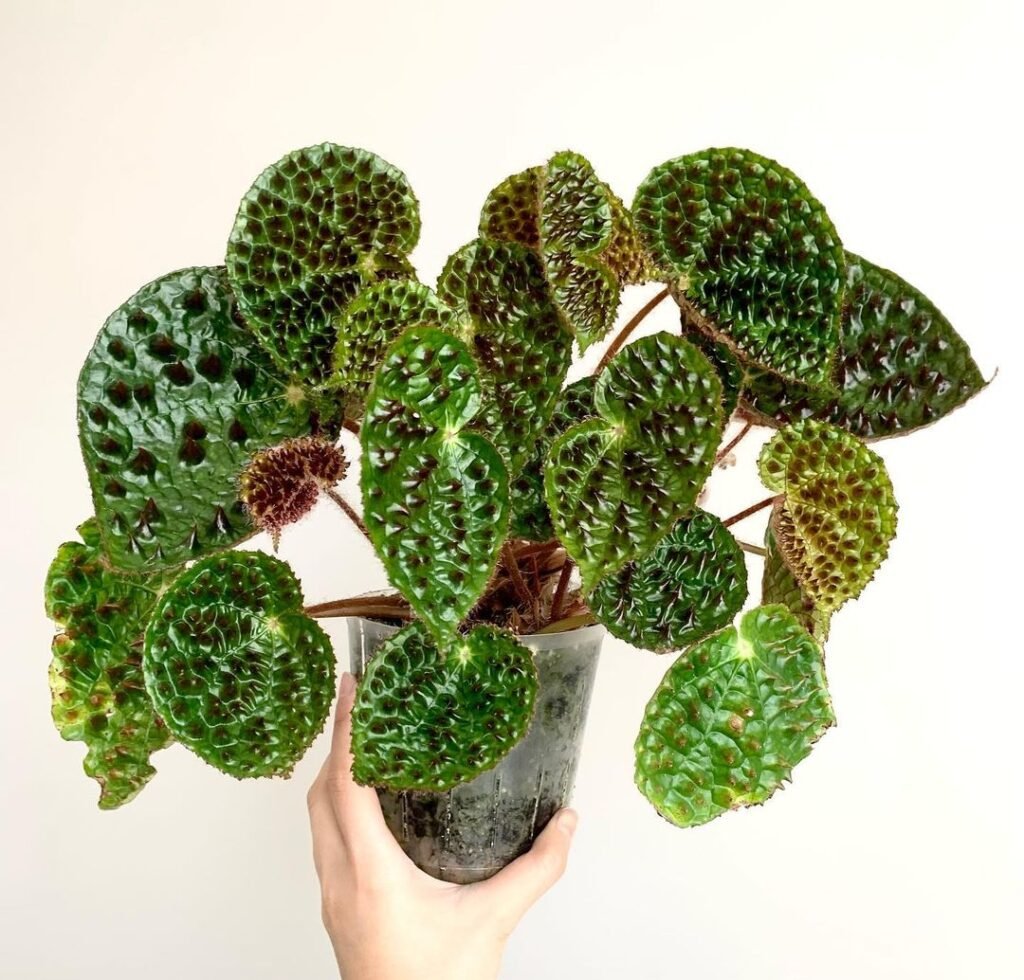


Genus Species
Begonia Ferox, scientifically known as Begonia ferox, belongs to the vast genus of begonias. Understanding its botanical classification sheds light on its relationships within the plant kingdom:
Begonia Genus Overview:
Begonias are a diverse group of flowering plants, with over 1,800 species, and they are widely admired for their ornamental qualities. These plants belong to the family Begoniaceae and are mainly native to tropical and subtropical regions around the world.
Begonia Ferox in the Genus:
Begonia Ferox is just one member of this extensive begonia family. Its unique foliage and manageable size make it a prized addition to collections of plant enthusiasts and gardeners. By learning more about its genus and family, we can better appreciate the botanical origins of this exceptional begonia.
Begonia Ferox Appearance

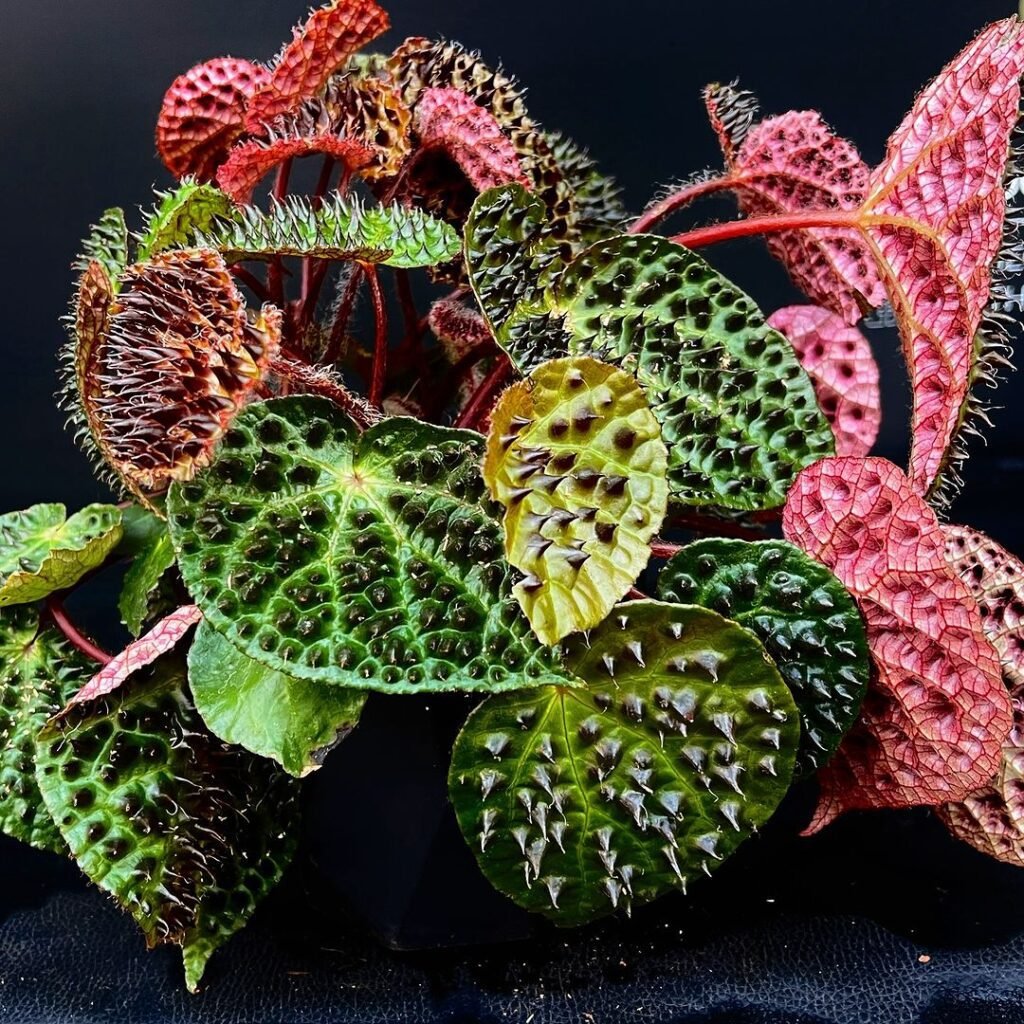
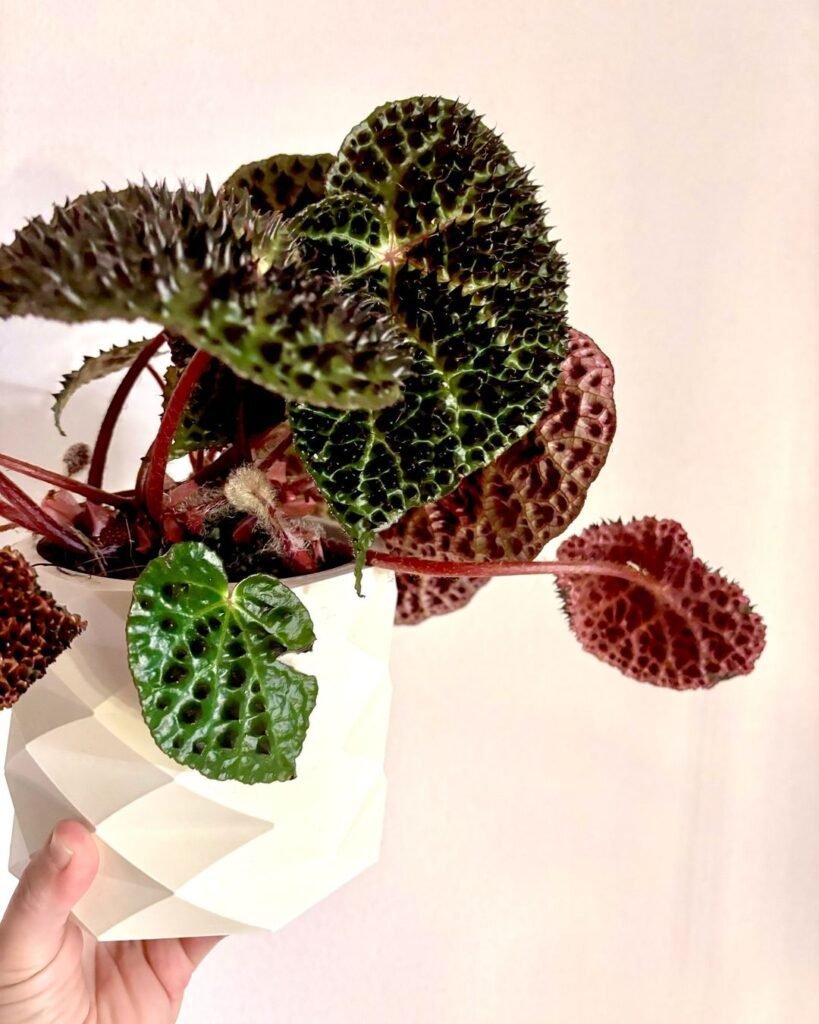
The appearance of Begonia Ferox is nothing short of mesmerizing. Its allure lies in the combination of distinctive features that make it a prized ornamental plant:
Leaves:
As mentioned earlier, the leaves of Begonia Ferox are a visual feast. They are asymmetrical and characterized by their rough, scaly texture, which gives the plant a reptilian look. These textured leaves are a deep green color, with a reddish underside, creating a striking contrast.
Size and Growth:
Begonia Ferox typically reaches a height of 12 to 18 inches and spreads to about 12 to 24 inches, making it ideal for potting or as a ground cover in the garden.
Flowers:
While the foliage takes center stage, Begonia Ferox does produce delicate white or pale pink flowers. However, these blooms are relatively inconspicuous compared to the captivating leaves.
Seasonal Changes:
The appearance of this begonia can vary slightly with changing seasons. In the colder months, you might notice the leaves becoming more vibrant and red, adding to its visual appeal.
Not the plant for you? Check out my full list of 78 Types of Begonia!
Begonia Ferox Care Tips
To ensure the health and vibrancy of your Begonia Ferox, it’s essential to provide proper care and attention. Here are some valuable care tips for this unique plant:
1. Lighting Requirements:
- Indirect Light: Begonia Ferox thrives in bright, indirect light. Avoid exposing it to direct sunlight, as this can scorch its delicate leaves.
2. Soil Selection:
- Well-Draining Soil: Use a well-draining potting mix to prevent waterlogged roots. A mix with peat, perlite, and compost works well.
3. Watering Schedule:
- Moderate Watering: Allow the top inch of soil to dry before watering. Overwatering can lead to root rot, so be cautious.
4. Humidity Level:
- High Humidity: Begonia Ferox loves humidity. You can maintain humidity by misting the plant or using a humidity tray.
By following these care tips, you’ll be well on your way to maintaining a healthy and thriving Begonia Ferox.

Begonia Ferox Light and Soil Requirements
Proper lighting and soil conditions are crucial for the well-being of your Begonia Ferox. Let’s explore the specific requirements:
Light Conditions:
- Indirect Bright Light: Begonia Ferox thrives in bright, indirect sunlight. Place it near a window with a sheer curtain or in a location with filtered light to protect its delicate leaves from scorching.
- Avoid Direct Sun: Direct sunlight can damage the leaves, so it’s best to shield the plant from harsh rays.
Soil Requirements:
- Well-Draining Soil: Choose a well-draining potting mix that allows excess water to escape. A mix containing peat, perlite, and compost is ideal.
- Acidic Soil: Begonia Ferox prefers slightly acidic soil with a pH range of 5.5 to 6.5.
- Repotting: Repot your Begonia Ferox every 1-2 years to refresh the soil and give the plant more room to grow.
Soil Moisture:
- Moderate Moisture: Water the plant when the top inch of soil feels dry to the touch. Avoid overwatering, as this can lead to root rot.
- Humidity: Maintain a humid environment to mimic its natural rainforest habitat. Regular misting or using a humidity tray can help achieve this.
Watering Begonia Ferox
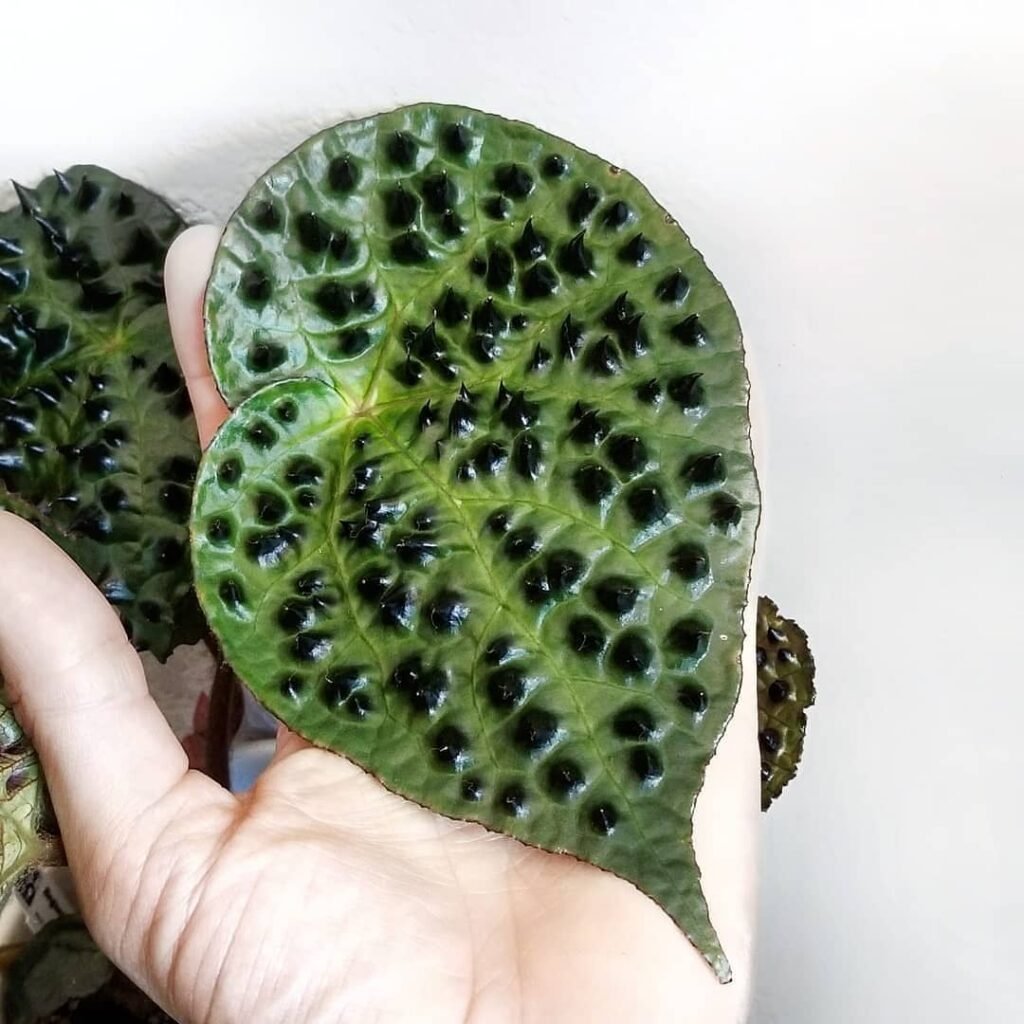
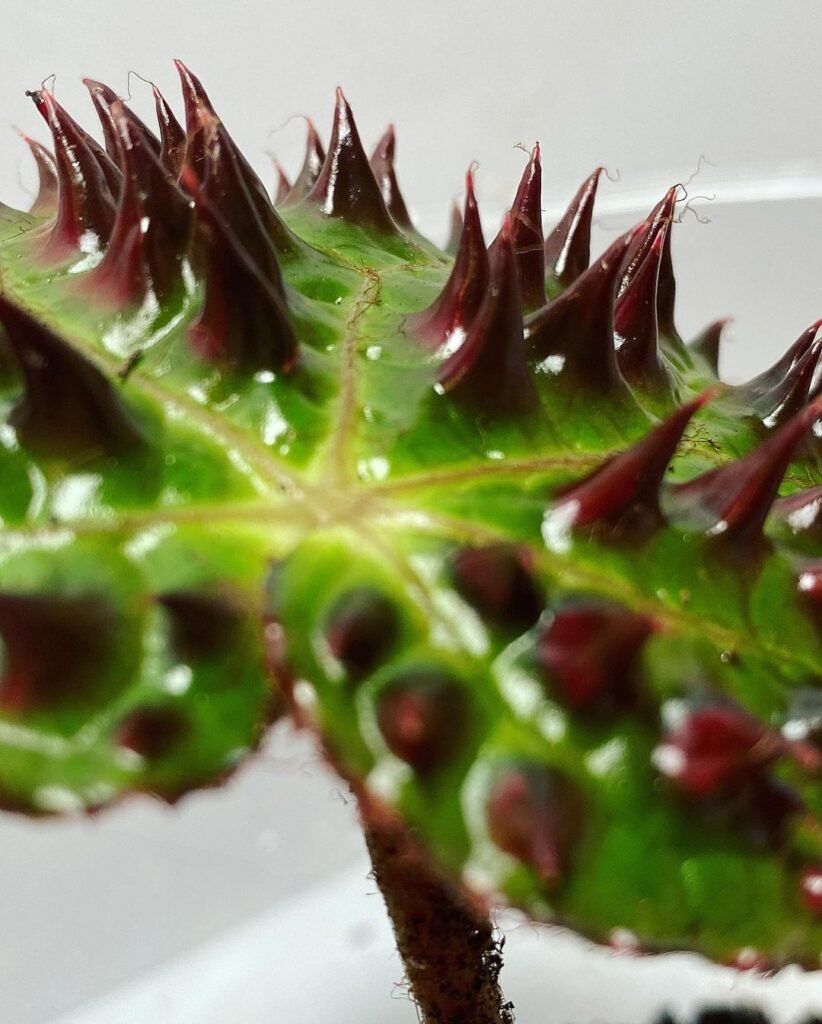
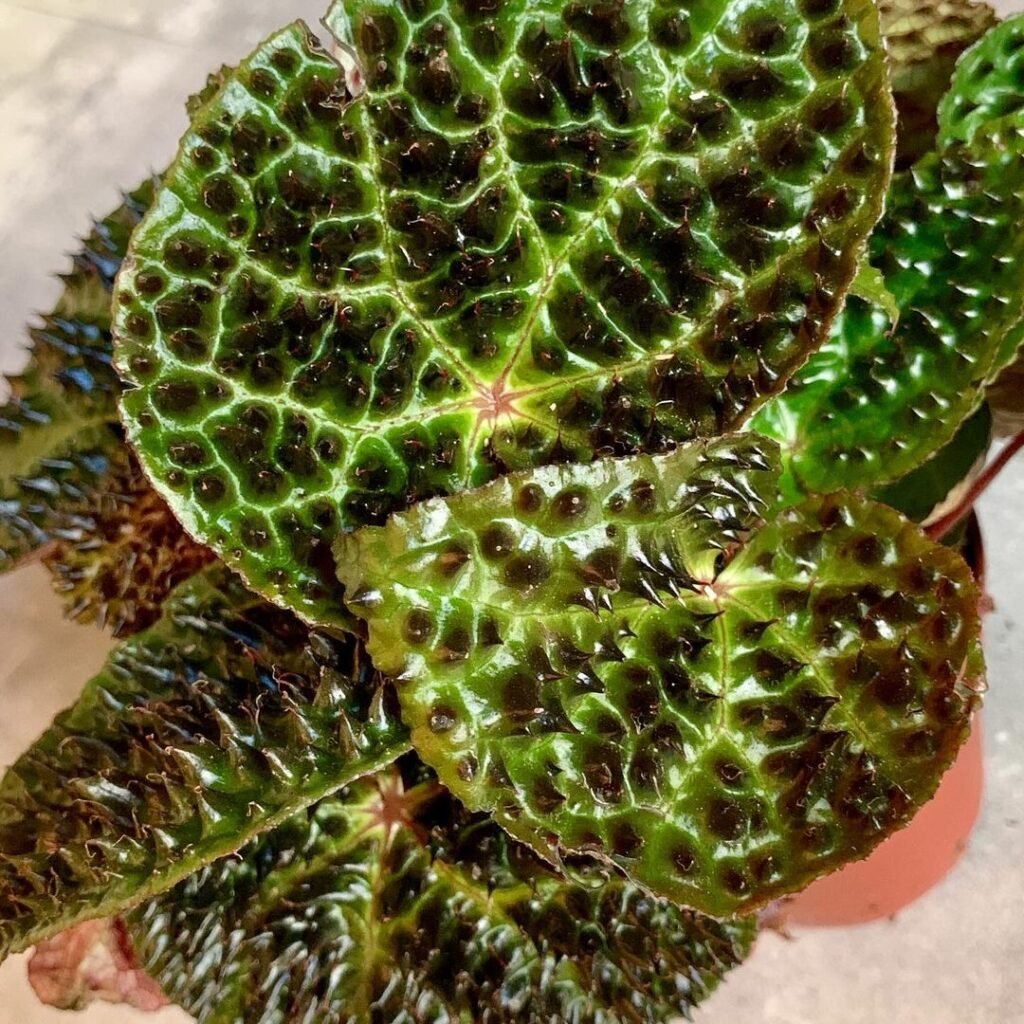
Proper watering is essential for the health of your Begonia Ferox. Here’s a detailed guide on watering practices:
1. Water Quality:
- Use Filtered Water: Begonia Ferox is sensitive to chemicals in tap water, so it’s best to use filtered or distilled water. This helps prevent leaf damage and brown spots.
2. Watering Schedule:
- Let Soil Dry: Water the plant when the top inch of the soil feels dry. Overwatering can lead to root rot, so ensure that the pot has proper drainage.
3. Watering Technique:
- Bottom Watering: To prevent wetting the foliage, consider bottom watering by placing the pot in a tray of water. Allow the soil to soak up moisture for a few minutes, then remove the pot from the tray.
4. Reduce Water in Winter:
- During the colder months, reduce the frequency of watering, as the plant’s growth slows down. Be extra cautious to avoid overwatering in winter.
Begonia Ferox Humidity and Temperature
Creating the right environmental conditions is essential for the well-being of your Begonia Ferox. Here’s what you need to know:
Humidity Requirements:
- High Humidity: Begonia Ferox is native to rainforests, so it thrives in high humidity. You can increase humidity by misting the plant regularly or placing a humidity tray nearby.
- Grouping Plants: Placing it near other houseplants can also help increase the humidity around the begonia.
Temperature Range:
- Ideal Temperature: Maintain a temperature range of 65-75°F (18-24°C) during the day. Avoid exposing the plant to temperatures below 50°F (10°C).
- Cold Drafts: Protect the begonia from cold drafts, which can lead to stress and leaf damage.
Here’s a table summarizing the ideal conditions for Begonia Ferox:
| Condition | Ideal Range |
|---|---|
| Light | Indirect bright light |
| Soil | Well-draining, slightly acidic |
| Soil Moisture | Let top inch dry |
| Water Quality | Filtered or distilled |
| Humidity | High humidity |
| Temperature | 65-75°F (18-24°C) during the day |
| Cold Tolerance | Avoid temperatures below 50°F (10°C) |
By following these guidelines, you can provide the optimal environment for your Begonia Ferox to thrive.
Fertilizing Begonia Ferox


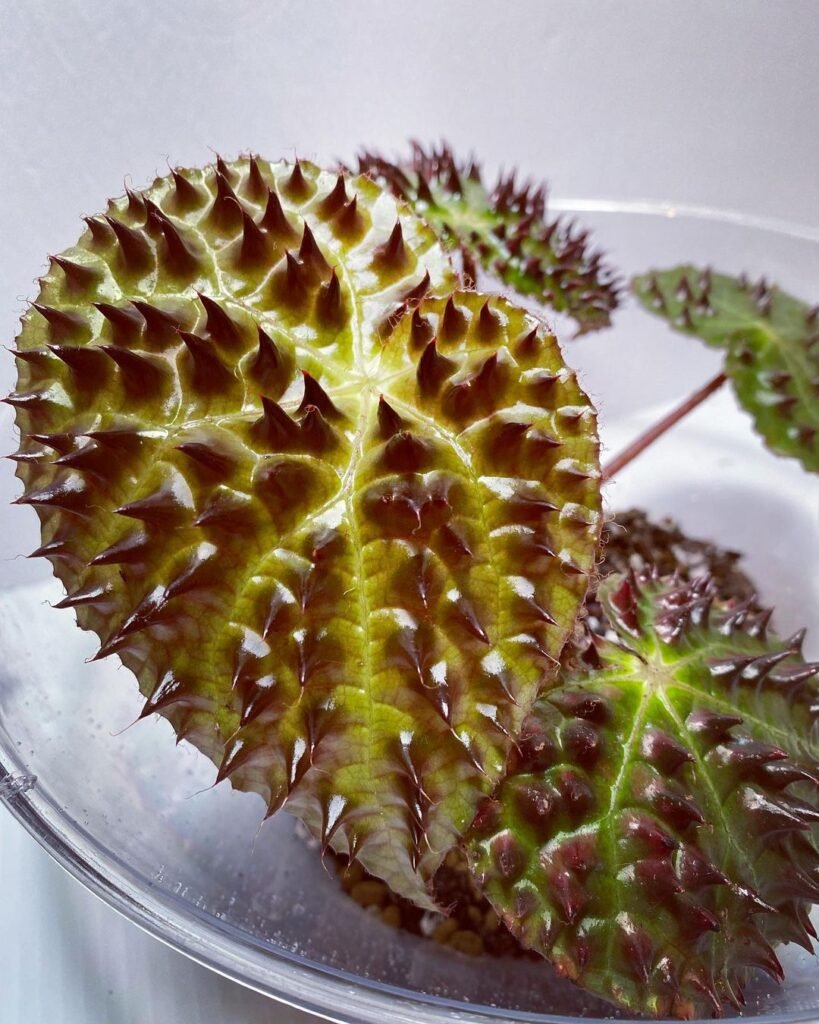
Fertilizing your Begonia Ferox is essential to promote healthy growth and vibrant foliage. Here are some key points to consider:
Fertilizer Type:
- Balanced Fertilizer: Use a balanced, water-soluble fertilizer with equal parts of nitrogen, phosphorus, and potassium. A 20-20-20 or 10-10-10 blend is suitable.
- Reduced Strength: During the growing season (spring and summer), dilute the fertilizer to half the recommended strength. Fertilize once a month.
- No Fertilization in Winter: Reduce or completely stop fertilization in the dormant winter months.
Application:
- Root Zone Feeding: Apply the fertilizer to the soil around the root zone, avoiding direct contact with the leaves.
- Avoid Overfeeding: Be cautious not to over-fertilize, as this can lead to nutrient imbalances and potential damage to the plant.
Begonia Ferox Pruning and Shaping
Pruning and shaping your Begonia Ferox can help maintain its size and appearance. As the plant grows, you may notice some leggy or damaged stems. To keep it looking its best, trim these stems with clean, sharp scissors or pruning shears. You can also pinch the growing tips to encourage bushier growth. Pruning is typically done during the active growing season in spring or early summer.
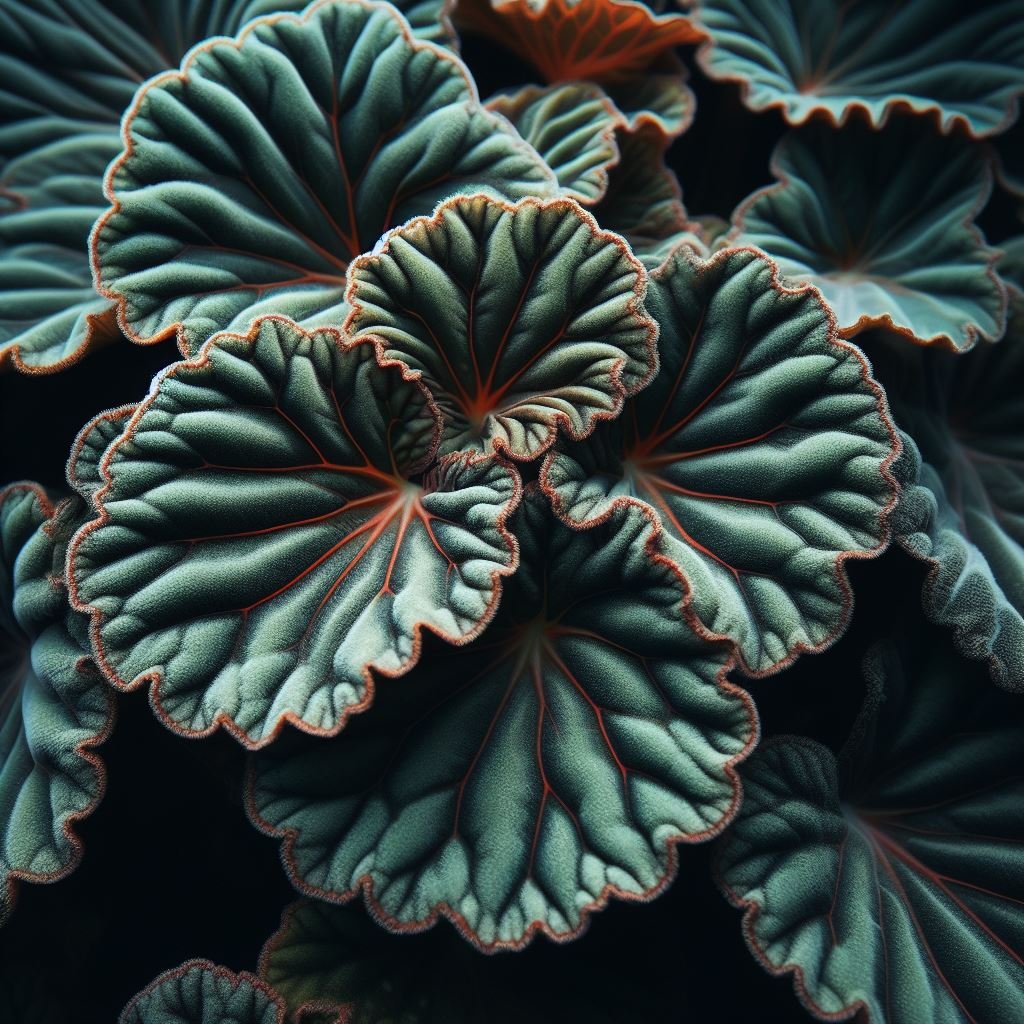
Begonia Ferox Propagation and Repotting
Propagation allows you to create new Begonia Ferox plants, and repotting helps keep your existing one healthy. Here are some steps to consider:
- Propagation: You can propagate Begonia Ferox through stem cuttings. Take a healthy cutting, dip it in rooting hormone, and plant it in a well-draining potting mix. Keep it in a humid environment until roots develop.
- Repotting: As your begonia grows, you may need to repot it every 1-2 years or when it outgrows its current container. Choose a slightly larger pot with good drainage, refresh the soil, and carefully transfer the plant.
Begonia Ferox Seasonal Care
Understanding how to care for your Begonia Ferox throughout the changing seasons is crucial for its well-being. Here’s a brief overview:
- Spring and Summer: During the growing season, maintain regular watering, humidity, and feeding. Keep the plant in bright, indirect light.
- Fall: As the days shorten, reduce feeding and prepare your begonia for dormancy. This means lowering the temperature and cutting back on watering.
- Winter: In winter, your Begonia Ferox may go somewhat dormant. Reduce both watering and feeding, and ensure it’s protected from cold drafts.
| Season | Care Guidelines |
|---|---|
| Spring/Summer | Regular watering, feeding, bright light |
| Fall | Reduce feeding, prepare for dormancy |
| Winter | Reduce watering and feeding, protect from drafts |
Begonia Ferox Companion Plants
Choosing the right companion plants can enhance the overall aesthetic of your garden or indoor plant collection. Begonia Ferox pairs well with certain other plants that share similar care requirements:
- Ferns: Ferns, with their lush, green fronds, complement the textured leaves of Begonia Ferox. Both thrive in high humidity and indirect light.
- Peperomia: Peperomia plants have similar care needs and add variety to the mix with their unique foliage patterns.
- Calathea: Calathea species, with their colorful and striking leaves, create a visually appealing contrast when placed near your Begonia Ferox.
Pest Control Tips for Begonia Ferox
Maintaining a pest-free environment is crucial for the well-being of your Begonia Ferox. Here are some tips for pest control:
- Inspect Regularly: Regularly inspect your plant for signs of pests such as mealybugs, spider mites, and aphids. Early detection is key to effective control.
- Natural Remedies: If you notice pests, you can use natural remedies like neem oil or insecticidal soap. Be sure to follow the instructions on the product label.
- Isolation: If your Begonia Ferox becomes infested, consider isolating it from other plants to prevent the pests from spreading.
Reviving a Sick or Wilting Begonia Ferox
Sometimes, despite your best efforts, your Begonia Ferox may not be at its healthiest. If you notice wilting or signs of distress, here’s what you can do to revive it:
- Assess the Cause: First, identify the issue. Is it overwatering, underwatering, or a pest problem?
- Adjust Watering: If it’s a watering issue, adjust your watering routine to either increase or decrease moisture as needed.
- Pruning: Trim any damaged or yellowing leaves to promote new growth.
- Repotting: If the roots are congested or the soil has deteriorated, repot your begonia into fresh soil in a slightly larger pot.
Love all types of Begonia? Make sure to catch up on my post on how to care and grow for begonia amphioxus. After you’ve finished reading that, why not also check out my care guide on how to grow begonia boliviensis.
Conclusion
In conclusion, Begonia Ferox is a captivating and unique plant that can thrive with the right care and attention. Its distinct appearance and manageable size make it a popular choice among plant enthusiasts. By providing the correct lighting, soil, and humidity, along with proper watering and feeding, you can enjoy the beauty of this begonia in your home or garden.
FAQs
How often should I water my Begonia Ferox?
Begonia Ferox prefers to be watered when the top inch of soil feels dry. It’s essential to let the soil partially dry out between waterings to prevent overwatering.
Can I place my Begonia Ferox in direct sunlight?
No, Begonia Ferox is sensitive to direct sunlight, which can scorch its leaves. It thrives in bright, indirect light or filtered sunlight.
What should I do if my Begonia Ferox is wilting?
If your Begonia Ferox is wilting, assess the cause, which could be overwatering, underwatering, or other issues. Adjust your care routine accordingly, trim damaged leaves, and consider repotting if necessary.
Is Begonia Ferox toxic to pets?
Yes, Begonia Ferox is toxic to pets if ingested. Keep it out of their reach to ensure their safety.
By following these tips and guidelines, you can successfully care for your Begonia Ferox and enjoy its unique beauty in your home or garden.

Writer/Green Thumb/Explorer – Rooted deep in the rich soils of Devon, I’ve cultivated a vast expertise in plant care, helping greenery thrive in homes across the UK. When I’m not crafting detailed plant care guides, I’m journeying through the lush landscapes of the West Country, unearthing nature’s secrets and sharing them with fellow plant enthusiasts. Every leaf has a story, and I’m here to tell it.





